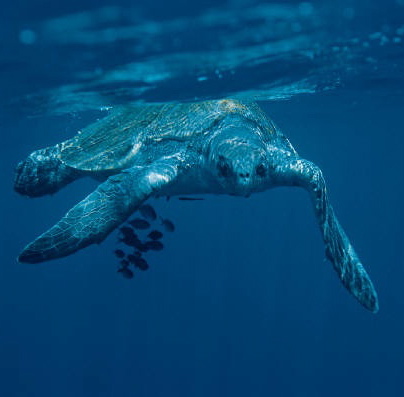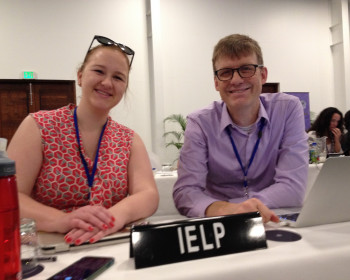IELP plays central role in agreement for the conservation of sea turtles
Open gallery

On May 8, 1998, the governments of Costa Rica and Panama signed the Cooperative Agreement for the Conservation of Sea Turtles of the Caribbean Coast of Costa Rica, Nicaragua, and Panama. Although Nicaragua has not yet signed the agreement, the completion of the agreement successfully concluded a long, collaborative effort to protect sea turtles among lawyers, biologists, educators, and politicians in several Caribbean nations. The International Environmental Law Project (IELP) played a central role in its development.
The mysterious life history of sea turtles continues to baffle biologists. No one knows, for example, where sea turtles go for a significant part of their lives. At the same time, they are under threat from habitat destruction of their nesting beaches, international and domestic trade for souvenirs, domestic trade for food, shrimping, disorientation of hatchlings due to lights, among other things.
IELP Director Chris Wold, working with students at Northwestern School of Law of Lewis & Clark College, prepared the background research. The paper, The Status of Sea Turtles Under International Environmental Law and International Environmental Agreements, demonstrates the ineffectiveness of current international environmental law to protect sea turtles on their nesting beaches and in the ocean. Meanwhile, Central American lawyers assessed the laws of Costa Rica, Nicaragua, and Panama and found that domestic laws also failed to protect sea turtles.
Based on these findings, IELP reviewed the biological literature for clues to legal mechanisms that might help protect sea turtles from an incredible array of threats. IELP quickly learned that protection of nesting beaches against light pollution, which disorients hatchlings and sends them toward the lights rather than the ocean, would not protect sea turtles from shrimp trawl nets. Protection from shrimp trawl nets would not protect sea turtles from unsustainable subsistence use. In the end, IELP prepared a comprehensive draft of a treaty.
A lawyer’s reading of the biological literature is most likely to be inadequate. As a result, IELP Director Chris Wold met with sea turtle biologists, as well as other lawyers and experts in sea turtle conservation. Those meetings helped ensure that the legal mechanisms in the treaty were biologically meaningful and that legally meaningful provisions would protect the biological needs of sea turtles. From these rich discussions, the group prepared the Draft Agreement for the Conservation of Sea Turtles on the Caribbean Coast of Panama, Costa Rica and Nicaragua (Annotated).
The lawyers and biologists believed that they had prepared a biologically and legally defensible treaty that the Costa Rica, Nicaragua, and Panama could support. Nonetheless, politics played a significant role in limiting the scope of the treaty. For example, the draft agreement called for a Sea Turtle Conservation Advisory Committee to prepare a regional management agreement to conserve shared sea turtle populations. The Committee, composed of shrimpers, scientists, local communities and other, would review petitions for exemptions from the treaty’s basic prohibition against killing sea turtles. In the end, the governments limited the composition of the Committee and limited its duties to oversight of the preparation of the management plan. For a summary of the draft agreement’s key provisions, see Overview of the Draft Agreement for the Conservation of Sea Turtles on the Caribbean Costa of Panama, Costa Rica, and Nicaragua.
Nonetheless, the drafting group recognized that their draft was not a fait accompli, but rather a basis from which to begin regional cooperation. The final agreement signed by Costa Rica and Panama, provides a useful starting point from which to conserve shared populations of sea turtles in the Caribbean. For example, it provides one means to implement on a regional basis the recently signed Inter-American Convention for the Protection and Conservation of Sea Turtles, an agreement signed by nations in the western hemisphere.
Participants in the Drafting Group
-
Lucinda Taft, Caribbean Conservation Corporation
-
Lizbeth Espinoza, CEDARENA
-
Mario Boza, WCS/CCC
-
Chris Wold, Center for International Environmental Law
-
Thomas T. Ankersen, University of Florida College of Law
-
Anne Meylan, Marine Turtle Specialist Group
-
Peter Meylan, Marine Turtle Specialist Group
-
Note: IELP had no formal structure at the time of this project. As a result, Chris Wold’s participation in this project was through the Center for International Environmental Law.
Project Resources
-
IELP The Status of Sea Turtles Under Int’l Envtl Law and Int’l Envtl Agreements
-
Inter-American Convention for the Protection and Conservation of Sea Turtles
General Resources
-
Agreement for the Conservation of Sea Turtles on the Caribbean Coast of Panama, Costa Rica and Nicaragua (Official Spanish Text)
-
Sea Turtle Conservancy (world’s oldest sea turtle research and conservation organization)
-
Conservation Clinic of the University of Florida School of Law (clinic directed by drafting group member, Professor Thomas T. Ankersen)
-
NOAA Fisheries: Sea Turtle Protection and Conservation (US government site on sea turtle species and conservation)
More Global Law Alliance for Animals and the Environment Stories
Global Law Alliance for Animals and the Environment is located in Wood Hall on the Law Campus.
MSC: 51
email ejt@lclark.edu
Global Law Alliance for Animals and the Environment
Lewis & Clark Law School
10101 S. Terwilliger Boulevard MSC 51
Portland OR 97219

